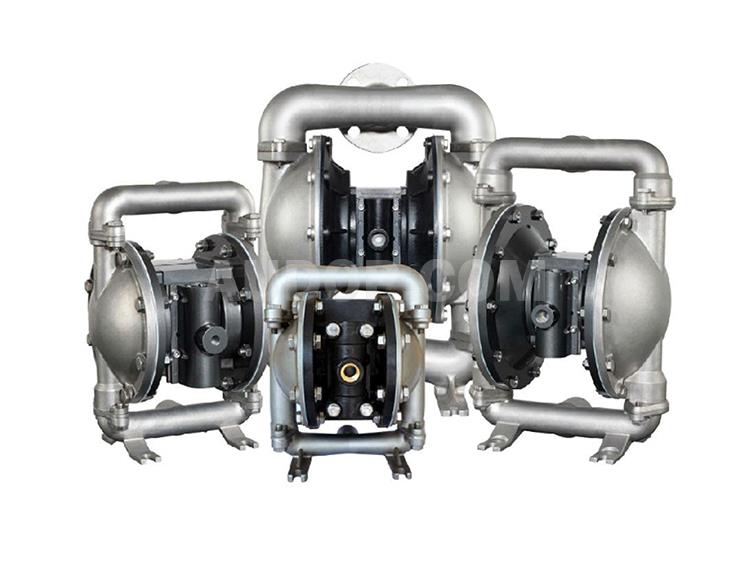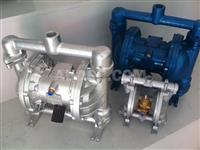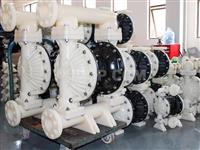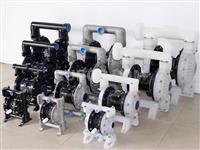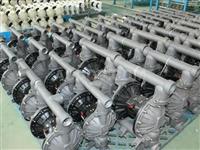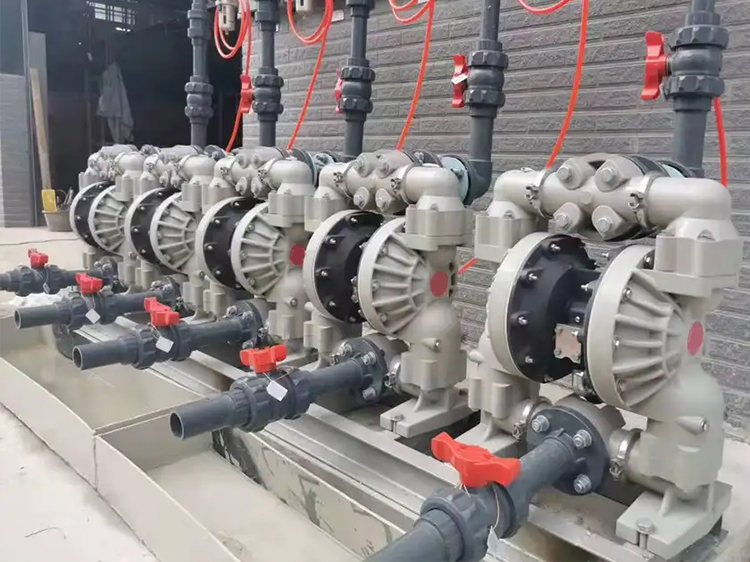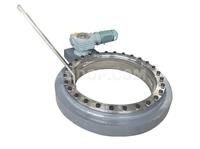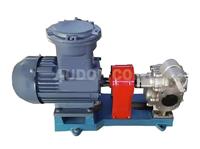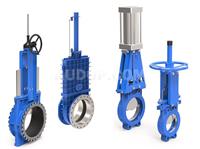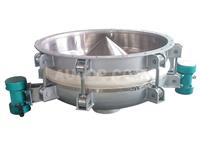Pneumatic Diaphragm Pump
- No priming water is required. The pneumatic diaphragm pump has a suction lift of up to 7m, a head of up to 50m, and an outlet pressure of ≥6kgf/cm².
- It features a large flow channel and excellent passage performance, allowing the passage of large particles with a diameter of up to 10mm. When pumping mud and impurities, the wear on the pneumatic diaphragm pump is minimal.
- The head and flow rate of the pneumatic diaphragm pump can be infinitely adjusted by adjusting the opening of the air valve (air pressure adjustment range: 1-7kgf/cm²).
- The pneumatic diaphragm pump has no rotating parts and no shaft seals. The diaphragm completely isolates the pumped medium from the pump's moving parts and working medium, preventing the conveyed medium from leaking outward. Therefore, when pumping toxic, volatile, or corrosive media, it does not cause environmental pollution or pose risks to personal safety.
- It does not require electricity, making the pneumatic diaphragm pump safe and reliable for use in flammable and explosive areas.
- The pneumatic diaphragm pump can be submerged in the medium for operation.
- The pneumatic diaphragm pump is easy to operate and reliable in performance. It can be started or stopped simply by opening or closing the air valve. Even if it operates without medium for a long time due to unexpected situations or shuts down suddenly, the pump will not be damaged. In case of overload, the pneumatic diaphragm pump will automatically shut down, featuring self-protection performance. When the load returns to normal, it will automatically start and operate again.
- The pneumatic diaphragm pump has a simple structure and few wearing parts. It is easy to install and maintain. The medium conveyed by the pump does not come into contact with moving parts such as the air distribution valve and connecting rod — unlike other types of pumps, whose performance gradually degrades due to wear of parts like rotors, pistons, gears, and blades.
- The pneumatic diaphragm pump can convey relatively viscous liquids (viscosity below 10,000 centipoise).
- The pneumatic diaphragm pump does not require oil lubrication. Even if it idles, it has no impact on the pump — this is a major feature of the pump.
Overview
The QBY series pneumatic diaphragm pump is a new type of conveying machinery and a novel pump type currently available in the market.Powered by compressed air from an air compressor, this pneumatic diaphragm pump can completely pump and drain various liquids, including corrosive liquids, particle-containing liquids, high-viscosity liquids, volatile liquids, flammable liquids, and highly toxic liquids.It is available in eight conventional diameter specifications: 10mm (3/8"), 15mm (1/2"), 25mm (1"), 40mm (1 1/2"), 50mm (2"), 65mm (2 1/2"), 80mm (3"), and 100mm (4") — meeting diverse application needs of pneumatic diaphragm pump users.Three material options are provided for the pneumatic diaphragm pump: aluminum alloy, cast iron, and stainless steel.To meet the needs of different users, the diaphragms of the pneumatic diaphragm pump are made of nitrile rubber, neoprene rubber, fluororubber, or polytetrafluoroethylene (PTFE) depending on the type of liquid medium being handled.This pneumatic diaphragm pump is widely used in industries such as petroleum, chemical engineering, electronics, ceramics, textiles, paint, and pharmaceuticals. It is designed to pump various media that cannot be handled by conventional pumps.
Working Principle of Pneumatic Diaphragm Pump:
The working principle of a pneumatic diaphragm pump (a positive displacement reciprocating pump) is as follows: An air compressor delivers compressed air into the pump. The air distribution valve then drives the connecting shaft inside the pump's central body, which in turn drives the diaphragm inside the medium chamber of the pump body to perform horizontal stretching movements, thereby achieving the self-priming function for fluids.Inside the two symmetric working chambers of the pneumatic diaphragm pump, there is one flexible diaphragm in each chamber. A connecting rod integrates the two diaphragms into a single unit. After compressed air enters the air distribution valve through the pump's air inlet connector, it pushes the diaphragms in the two working chambers, driving the two diaphragms connected by the rod to move synchronously.At the same time, the gas in the other working chamber is discharged out of the pneumatic diaphragm pump from the back of the diaphragm.A pneumatic diaphragm pump consists of two main parts: an air flow structure and a liquid flow structure, which are completely isolated by the diaphragms on both sides.The pump can operate as long as the air source pressure is greater than 2 kg/cm².Under a working pressure of 5-8 kg, the high-pressure gas in the air valve chamber drives the connecting rod shaft to perform left-right reciprocating movements through the air flow guidance system. Meanwhile, the low-pressure gas after consumption is quickly discharged through the exhaust port of the pneumatic diaphragm pump.Under the alternating action of high-pressure and low-pressure gas on both sides, the connecting rod shaft drives the diaphragms on both sides to move left and right, causing alternating changes in air pressure in the volume chambers on both sides. This enables the continuous suction and discharge of liquid by the pneumatic diaphragm pump.The air distribution mechanism automatically introduces compressed air into the other working chamber, pushing the diaphragm to move in the opposite direction. This forms the synchronous reciprocating movement of the two diaphragms in the pneumatic diaphragm pump.Each working chamber of the pneumatic diaphragm pump is equipped with two one-way ball valves. The reciprocating movement of the diaphragm changes the volume inside the working chamber, forcing the two one-way ball valves to open and close alternately, thereby continuously sucking in and discharging the liquid.
Operation Precautions for Pneumatic Diaphragm Pump:
Start-up and shutdown load operation of the pneumatic diaphragm pump: The pneumatic diaphragm pump is driven by a variable-frequency motor. To avoid excessive or insufficient load during start-up and shutdown, it is strictly regulated that the load during start-up and shutdown should be controlled at around 30%. In addition, the instrument is set to ensure that load increase or decrease must be completed within a certain period of time — effectively maintaining the frequency converter from a process perspective.
Operation of the instrument air and lubricating oil pressure system for the pneumatic diaphragm pump.
The instrument air pressure and lubricating oil pressure of the pneumatic diaphragm pump are interlocked with the main motor. The oil injection and oil discharge valves for the propellant fluid are air-closed valves, which require a constant air pressure to be maintained at all times. The minimum operating pressure for these two valves is not less than 0.4MPa, so the instrument air pressure is generally maintained above 0.5MPa. Even after the pneumatic diaphragm pump is shut down, the instrument air supply is not turned off to prevent insufficient or excessive fluid in the propellant fluid chamber. The air supplied to the valves is filtered and oil-atomized.During the operation of the pneumatic diaphragm pump, the lubricating oil pressure should not be lower than the pressure interlock value (0.15MPa), and the pressure difference across the lubricating oil outlet filter should not be too large. The steel ball inside the lubricating oil flow sight glass should be at the upper limit position. When adjusting the flow rate, the adjustment range should not be too large to avoid an excessive instantaneous flow rate that causes the pressure to drop too quickly, leading to an interlock shutdown of the pneumatic diaphragm pump.
Installation Diagram of Pneumatic Diaphragm Pump:
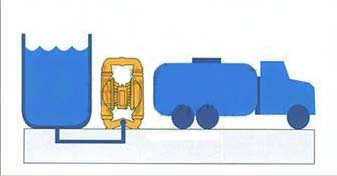
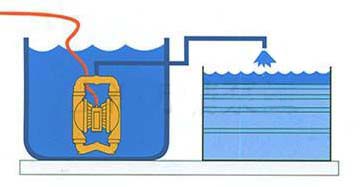
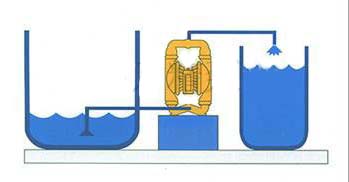
Technical Parameters
Technical Parameters
| Model | Maximum flow rate (m³/h) | Maximum flow rate (lpm) | Transportation distance (m) | Outlet pressure (kgf/cm²) | Suction distance (m) | Maximum material diameter(mm) | Supply pressure (kbf/c㎡) | Gas supply consumption (m³/min) |
| QBY-10 | 1.1 | 18.9 | 70 | 2.5-3 | 7 | 10 | 7 | 0.3 |
| QBY-15 | 1.1 | 18.9 | 70 | 2.5-3 | 7 | 15 | 7 | 0.3 |
| QBY-20 | 3.4 | 57 | 70 | 4.5-7.6 | 7 | 20 | 7 | 0.6 |
| QBY-25 | 3.4 | 57 | 70 | 4.5-7.6 | 7 | 25 | 7 | 0.6 |
| QBY-25A | 9 | 151 | 84 | 5.4 | 8.4 | 25 | 8.4 | 0.9 |
| QBY-32 | 9 | 151 | 84 | 5.4 | 8.4 | 32 | 8.4 | 0.9 |
| QBY-40 | 9 | 151 | 84 | 5.4 | 8.4 | 40 | 8.4 | 1.5 |
| QBY-50 | 22 | 378.5 | 84 | 5.48 | 8.4 | 50 | 8.4 | 1.5 |
| QBY-65 | 22 | 378.5 | 84 | 5.48 | 8.4 | 65 | 8.4 | 1.5 |
| QBY-80 | 34 | 568 | 84 | 5.48 | 8.4 | 80 | 8.4 | 2 |
| QBY-100 | 34 | 568 | 84 | 5.48 | 8.4 | 100 | 8.4 | 2 |
| QBY-125 | 62 | 1041 | 84 | 2.4-7.6 | 8.4 | 125 | 8.4 | 5 |
| QBY-150 | 62 | 1041 | 84 | 2.4-7.6 | 8.4 | 150 | 8.4 | 5 |
Your requirements are the basis for our development and a daily challenge to bring to fruition, please do not hesitate to inquiry us.
Scraper Arch Breaker
- High-Quality Material Guarantee: The main body is made of SUS304 stainless steel, which has stable physical properties. It is not only corrosion-resistant and wear-resistant but also meets the hygiene level requirements of the food and pharmaceutical industries, avoiding contamination when materials come into contact with the equipment. SUS304 stainless steel scraper arch breakers are safe for food-grade applications.
- Simple Structural Design: The overall structure has no complex redundant parts and adopts a "bolt-free" assembly process, reducing gaps for material accumulation and cleaning blind spots. During daily maintenance, there is no need to disassemble complex components; only the scraper wear condition and gear lubrication status need to be checked, which greatly reduces maintenance costs and downtime. Low-maintenance scraper arch breakers save production costs for factories.
- Long Service Life: The core transmission components (gears) adopt precision machining technology, and combined with the wear-resistant treatment of the scraper, mechanical loss during operation is reduced. At the same time, compared with chain transmission, the gear transmission method avoids the risk of chain loosening and breaking, and the average service life of the equipment is more than 30% longer than that of traditional discharging equipment. Long-life scraper arch breakers reduce equipment replacement frequency for manufacturers.
- Significant Arch-Breaking and Wall-Cleaning Effect: The design of the scraper making circular motion along the silo wall can directly act on the retained materials on the side walls and bottom of the silo. It not only solves the "bridging" and "hollowing" problems but also cleans the materials attached to the silo wall, avoiding caking and deterioration caused by long-term material retention and improving material utilization rate. Scraper arch breakers with excellent wall-cleaning function enhance production efficiency.
- Alleviating Material Segregation: For mixed materials with uneven particle sizes, traditional discharging methods are prone to "segregation" (large particles concentrate at the bottom and small particles concentrate at the top) due to different particle settlement speeds, which affects subsequent production quality. The scraper arch breaker keeps the materials in a mixed state during the falling process through the uniform stirring and pushing of the scraper, effectively alleviating the segregation problem. Scraper arch breakers prevent material segregation for consistent product quality.
- Quiet Operation Experience: The gear transmission link adopts a high-precision meshing design, and combined with the lubrication treatment of bearings, the noise during operation is controlled below 60 decibels (equivalent to the volume of daily conversation), avoiding the harsh noise of traditional discharging equipment during operation and improving the workshop working environment. Quiet scraper arch breakers create a comfortable working environment for production line engineers.
- Wide Hopper Angle Adaptability: It can adapt to hopper angles within 45°. Whether it is a vertical silo or an inclined silo, accurate connection can be achieved by adjusting the installation angle, without the need for large-scale modification of the existing silo structure. Scraper arch breakers with flexible hopper angle adaptation fit various silo types.
- Rich Specifications and Customization Options: Standard caliber specifications from φ40 to φ500 are provided, covering different needs from small laboratory equipment to large-scale industrial production lines. For large-caliber needs beyond the standard caliber (such as above φ500), exclusive equipment can be customized through technical consultation according to the customer's silo size and material characteristics, ensuring seamless connection with the existing production system. Customizable scraper arch breakers meet diverse industrial needs for purchasers.
- Expandable Blade Design: It supports the installation of multiple scraper blades (the specific number is determined according to material fluidity and discharging volume). The more blades there are, the higher the discharging efficiency and the more uniform the material stirring, which can be flexibly adjusted according to the actual production rhythm. Expandable blade scraper arch breakers optimize discharging efficiency for different production beats.
KCB Series Gear Pump
- KCB Series Gear Pump is mainly composed of gears, shafts, pump body, relief valve and shaft end seal. The gears undergo heat treatment to achieve high hardness and strength, and are installed in replaceable shaft sleeves together with the shafts for operation. The lubrication of all parts in the KCB Series Gear Pump is automatically achieved by using the output medium when the pump is working.
- The pump is designed with reasonable oil discharge and oil return grooves, which reduce the torque force borne by the gears during operation. As a result, the bearing load is small, wear is minimal, and the KCB gear oil pump has high efficiency.
- KCB Gear Pump is equipped with a relief valve for overload protection. The full return pressure of the relief valve is 1.5 times the rated discharge pressure of the pump. The KCB gear oil pump can also be adjusted separately according to actual needs within the allowable discharge pressure range. However, it should be noted that this relief valve cannot work as a pressure reducing valve for a long time; if necessary, a separate pressure reducing valve can be installed on the pipeline. When viewing the pump from the extended end of the main shaft, the rotation direction is clockwise.
Knife Gate Valve
- Ultra-short structural length saves materials and greatly reduces the overall weight of the pipeline system matched with the knife gate valve.
- It occupies small effective space, effectively supports pipeline strength, and reduces the possibility of pipeline vibration when used with the knife gate valve.
- The gate plate of the knife gate valve is made of austenitic stainless steel, which greatly improves corrosion resistance and effectively prevents sealing leakage caused by gate plate corrosion.
- The upper sealing packing of the knife gate valve adopts flexible PTFE, ensuring reliable sealing and easy, flexible operation.
- The gate plate of the knife gate valve has a knife function, which can effectively cut off various impurities in the medium.
Bin Bottom Vibratory Discharger
- Low power consumption, high efficiency and obvious effect.
- The discharge hopper is integrally stamped, with good rigidity and smooth inner wall. The built-in tapered discharge plate protrudes upward to ensure no material residue in the discharger.
- The vibration force and amplitude can be easily adjusted.
- The fixing bolts of the discharge plate are assembled from top to bottom, which improves safety.
- Low noise generated by vibration, meeting environmental protection requirements.
- Safe and reliable to use, with safety protection devices.
- Simple and novel equipment structure, convenient installation and low maintenance rate.
Roots Blower
- It has the characteristic of forced transportation. Under the condition of a certain rotating speed, the flow rate is basically unchanged. Even in the small flow rate area, surge will not occur, and it has stable working characteristics.
- As a rotary machine, it has no reciprocating mechanism, no air valve, few wearing parts and a long service life.
- It inhales and exhausts air many times in one operation cycle. Compared with the piston compressor, the air flow speed is uniform and there is no air storage tank.
- There is a certain gap between the moving parts and the static parts, and no lubricating oil is needed in the chamber, which ensures that the transported gas is oil-free and no oil-gas separation device is required.
- There is no internal compression process, and the mechanical efficiency is high.
